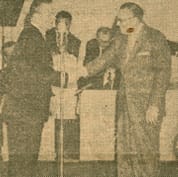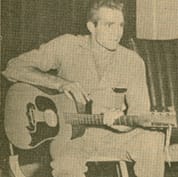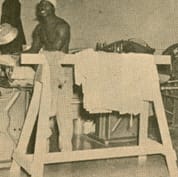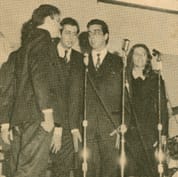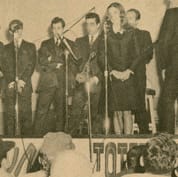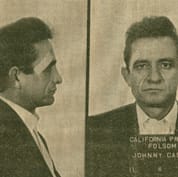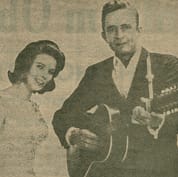During his time as a country music star, Johnny Cash was known as a voice for social awareness. He championed the plight of this country’s Native peoples with his Bitter Tears album. He welcomed Ray Charles onto ABC-TV’s The Johnny Cash Show, sharing a piano bench with him during the civil rights era.
He also never flinched in his advocacy for improved conditions for prison inmates and the value of drug rehabilitation programs.
Johnny Cash’s music resonates with empathy for inmates and the formerly incarcerated. At Folsom Prison, recorded live on January 13, 1968, and At San Quentin, recorded live on February 24, 1969 are touchstones in music history with songs like “Folsom Prison Blues,” and “I Walk the Line.”
Many things have changed over the past 50 years in the way the United States and California think about incarceration and the formerly incarcerated. One of the reasons for at least some of that change is Johnny Cash spotlighting the individuals behind bars and the treatment they received.
Dozens of Prison Concerts
The recorded concerts that served as the basis for Live at Folsom Prison (1968) and Live at San Quentin (1969) weren’t the only prison performances by Cash. In all, he did at least 30 prison concerts throughout the United States, including this one in 1980 at a California prison in Soledad.


One of the earliest was in California on New Year’s Day in 1958, part of a seven-hour entertainment marathon for the inmates in which Cash’s performance was the highlight. “Three Thousand San Quentin Men Cheer Stars — and Johnny Cash” says the headline of The San Quentin News, the inmate-published paper, for Thursday, January 9, 1958.
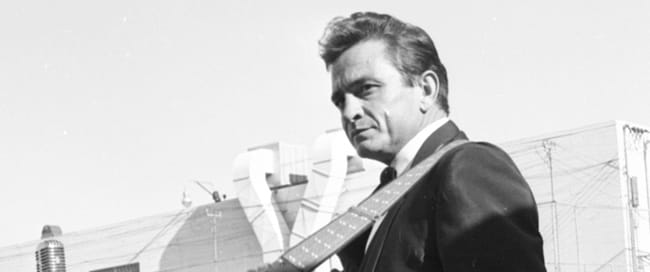
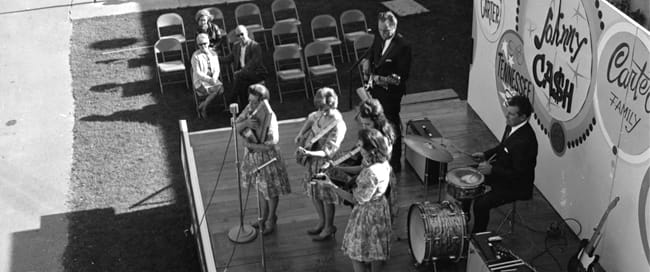
Cash was at Folsom multiple times, including November 8, 1966. Cash later described the prison audiences as being the most enthusiastic crowds he’d ever played for. A Sacramento Union photographer captured excitement from the inmates and the prison staff for the November 1966 outdoor concert. (Courtesy of Special Collections, UC Davis Library)
Recording a Prison Concert
In 1967, word began to circulate among the inmates at Folsom that Cash was interested in audio-recording a prison show for an album in May. “JOHNNY CASH SHOW [TO BE] TAPED HERE” screams the headline on the front page of the April 6, 1967, issue of the inmate paper The Folsom Observer. However, scheduling problems delayed the actual recording until January 1968. The same story includes a “mug shot” taken of Cash by the prison in November of 1966 — likely taken for fun, as Cash never served time in Folsom or any other prison beyond an evening or two in a local jail.
The recording of the January 1968 Folsom show includes Cash singing “Greystone Chapel,” a song written by a Folsom inmate who Cash acknowledges during the concert. Greystone Chapel still stands on the grounds of old Folsom State Prison and continues to be used as a meeting center. Efforts are being made to restore the chapel’s historic artwork.
Congressional Testimony
In July 1972, Cash and two former inmates testified before Congress on prison conditions.
“I have seen and heard of things at some of the concerts that would chill the blood of the average citizen,” Cash told the Subcommittee on National Penitentiaries. “But I think possibly the blood of the average citizen needs to be chilled in order for public apathy and conviction to come about because right now we have 1972 problems and 1872 jails…. People have got to care in order for prison reform to come about.”
Full Congressional Testimony
(Cash and others start on page 71 through page 88)
Presidential Visits
In addition to talking to Congress, Cash discussed ideas on how to improve prison conditions with political leaders whenever he got the chance. Cash and his wife June Carter met with Presidents Nixon, Ford, Carter, and Reagan (as president) as official guests at the White House. President Bill Clinton presented him with Kennedy Center Honors in 1996 and George W. Bush honored him with a National Medal of the Arts in 2001.
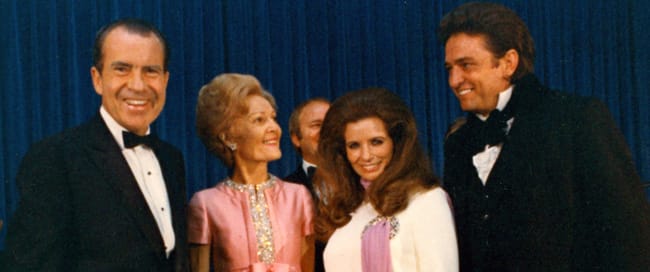
President Nixon
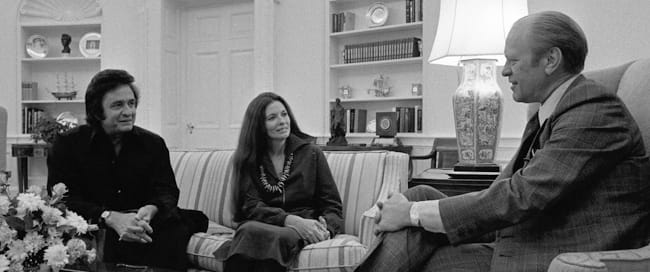
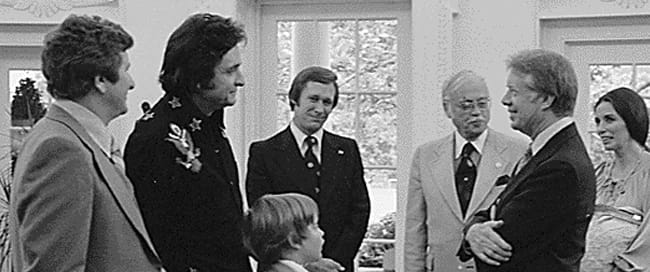
President Carter
President Reagan
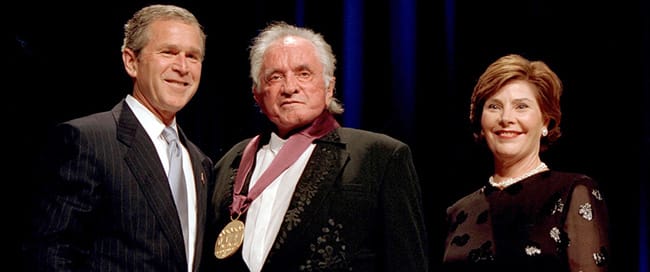
Merle Haggard
Country music legend Merle Haggard, an architect of the “Bakersfield Sound,” was an inmate at San Quentin in 1958. He was 20 years old, serving a two-year sentence for second degree burglary. Released on parole in 1960, he was pardoned 12 years later — after becoming an established music star — by then-Governor Ronald Reagan.
Haggard attended at least one of Cash’s concerts inside San Quentin in 1959 or 1960. Haggard talks about his time behind bars while performing on Cash’s television variety show in August 1969. As described by the Washington Post in 2016, Cash brings up San Quentin and something like this exchange followed:
Haggard: “Funny you mention that, Johnny.”
Cash: “What?”
Haggard: “San Quentin.”
Cash: “Why’s that?”
Haggard: “The first time I ever saw you perform, it was at San Quentin.”
Cash: “I don’t remember you being in that show, Merle.”
Haggard: “I was in the audience, Johnny.”
While ABC took flack for having a performer acknowledge his past life as a convict on live television, the controversy was short-lived.
- Washington Post article about Haggard viewing Cash’s first concert in San Quentin
- Rolling Stone interview with Haggard about Johnny Cash
Music folklore credits Cash’s concert as motivation for Haggard’s abandonment of criminal behavior, but Haggard in his autobiography My House of Memories cites the advice of fellow prisoners as having a greater impact, especially the perspective from “lifers” and those on Death Row. For Haggard, music set him straight.
“More than half of the convicts in the south block were like me — they wanted to be musicians,” Haggard writes about evenings in San Quentin when inmates could play instruments in their cells. “You could hear saxophones, guitars, banjos, and verbal fights and misunderstandings along with several instruments I couldn’t define.”
The cultural influence of Cash’s concerts extended beyond the inmates to include correctional staff and the local community. The Folsom Prison Museum, run by former correctional officers, references the recorded concert throughout its website, and the City of Folsom is in the process of constructing a scenic trail through the foothills of Folsom named in honor of Cash.
Visit the Exhibits
In addition to the photos and links here, please visit the State Capitol display area near the Governor’s Office to see over a dozen unique fine-art prints of the Johnny Cash concerts at Folsom and San Quentin in 1968 and 1969, provided through the generosity of the Estate of Jim Marshall. The photo display is expected to be available through August 24, 2018.
Afterwards, cross the street to the State Library in the Library & Courts Building at 914 Capitol Mall. In Room 220, see news clippings of Johnny Cash’s 1966 Folsom concert and other historical materials — along with social commentary artworks by Shepard Fairey inspired by photography from Jim Marshall.
Finally, as part of Sacramento’s Wide Open Walls festival, a downtown mural by Shepard Fairey is slated to be unveiled in mid-August based on the 1968 Folsom concert photography by Marshall. The original photo and Fairey’s artistic rendition of it that serves as the basis for the mural can both be seen at the State Library.
Additional References
Books
- Cash, Johnny with Patrick Carr, Cash the Autobiography, HarperCollins Publishers, Inc., New York, NY, 1997.
- D’Ambrisio, Antonino, Heartbeat and a Guitar: Johnny Cash and the Making of Bitter Tears, Perseus Books Group, New York, NY, 2009.
- Haggard, Merle and Tom Carter, Merle Haggard’s My House of Memories, HarperCollins Publishers, Inc. New York NY, 1999. Pages 140-142 recount the Johnny Cash concert.
- Horstman, Dorothy, Sing Your Heart Out, Country Boy, Country Music Foundation Press (distributed by Vanderbilt University Press), Nashville, TN, third printing 1996. Johnny Cash’s comment about “Folsom Prison Blues” is on page 291.
- Streissguth, Michael, Johnny Cash: the Biography, Perseus Books Group, New York, NY, 2006. Ray Charles’ performance on the Johnny Cash Show is on pages 168-169.
- Streissguth, Michael, Johnny Cash at Folsom Prison, the Making of a Masterpiece, Da Capo Press (Perseus Books), Cambridge, MA, 2004. A recounting of Governor Reagan’s visit to the rehearsals in West Sacramento for the 1968 recorded concert at Folsom is found on pages 67-69.
Articles
- Bunker, Edward, “Stuck in Folsom Prison: and Time Keeps Dragging On,” Los Angeles Times, April 30, 1972, page B7.
- Hilburn, Robert, “Johnny Cash Records Behind Walls of Folsom,” Los Angeles Times, February 11, 1968, page D7.
- McGinn, Aft, “Folsom Inmates Brave Chill for ‘Friend’ Cash,” Sacramento Bee, November 9, 1966, page A23.
- Silverman, Jonathan, “An Inadvertent Mirror: Johnny Cash and the American West,” The Journal of the American West, Fall 2011, Vol 50, No. 4, pages 39-43.
- Wren, Christopher, “The Restless Ballad of Johnny Cash,” LOOK Magazine, April 29, 1969, pages 68-75.


